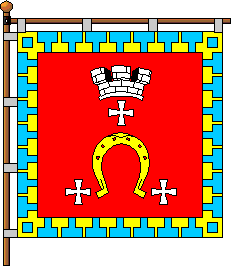 (1:1)
(1:1)from the site of Ukrainian Heraldry

Last modified: 2004-08-07 by dov gutterman
Keywords: kovel | volyinia | horseshoe | cross |
Links: FOTW homepage |
search |
disclaimer and copyright |
write us |
mirrors
 (1:1)
(1:1)
from the site of Ukrainian
Heraldry
See also:
From the site of Ukrainian
Heraldry:
"In September 16, 1993 by the decision No. 17/5 the session
of the town council approved the gonfalon: a square canvas . In a
red field there is a yellow horseshoe with three white crosses
around it - two on the sides, and one in the top; above the top
cross there is white town crown. Four sides of the gonfalon have
an edging of dark blue-yellow ornament with width of 1/10 of
width of the gonfalon."
Phil Nelson, 7 July 1999

from the site of Ukrainian
Heraldry
From the site of Ukrainian
Heraldry:
"On the 16th of September 1993 town council session of
Kovel' (resolution No.17/5) confirmed the modern CoA: in the
gules field the or horseshoe is accompanied above and on the
sides by three argent crosses. The horseshoe is a symbol of
blacksmith's trade and happiness. Argent crosses on gules
symbolizes Volyn'."
Phil Nelson, 7 July 1999
from the site of Ukrainian
Heraldry
"City in Volynia Oblast. The first mention refers to 1310.
Since 1518 the settlement was a town and got the name of Kovel'
and the Magdeburg Right. On a seal of 1872 there was a picture of
the Earth and a cross above it."
Phil Nelson, 7 July 1999
my ancient encyclopedia says, under the heading
"Magdeburg", "Magdeburg became a flourishing
commercial town during the 13th century, and was an important
member of the Hanseatic League..."Magdeburg law"
(Magdeburger Recht), securing the administrative independence of
municipalities, was widely adopted." Perhaps where the
source says "was given Magdeburg right" we should
translate "received the right of civic self-government"
or something similar.
John Ayer, 8 July 1999